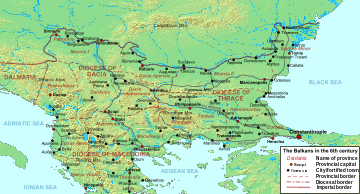Via Militaris

Via Militaris or Via Diagonalis was an ancient Roman road, starting from Singidunum (today the Serbian capital Belgrade), passing by Danube coast to Viminacium (mod. Požarevac), through Naissus (mod. Niš), Serdica (mod. Sofia), Philippopolis (mod. Plovdiv), Adrianopolis (mod. Edirne in Turkish Thrace), and reaching Constantinople (mod. Istanbul). This road was connected with Via Egnatia by other roads - the road along river Axios (or Vardar), the Serdica–Thessalonica road along river Strymon (or Struma), and the road Philippopolis–Philippi.
It was built in the 1st century AD. The length from Singidunum to Constantinople was 924 kilometres.[1]
During the first European conquests of Ottoman Turks orta kol (lit. middle arm) was following the Via Militaris. [2]
In May 2010, while work was done on the Pan-European Corridor X in Serbia, well-preserved remains of the road were excavated in Dimitrovgrad, Serbia. The eight-metre wide road was constructed from large blocks of stone and had two lanes.[3]
Key towns
| Ancient name | Location |
|---|---|
| Singidunum | Belgrade, Serbia |
| Gratiana | Dobra, Serbia |
| Viminacium | Kostolac, Serbia |
| Naissus | Niš, Serbia |
| Remesiana | Bela Palanka, Serbia |
| Serdica | Sofia, Bulgaria |
| Philippopolis | Plovdiv, Bulgaria |
| Hadrianopolis | Edirne, Turkey |
| Arcadiopolis | Lüleburgaz, Turkey |
| Byzantium | Istanbul, Turkey |
| Wikimedia Commons has media related to Via Militaris. |
References
- ↑ A Short History of the Yugoslav Peoples, p. 12, at Google Books
- ↑ Kılıç, Ayşegül; Bir Osmanlı Akın Beyi Gazi Evrenos Bey İthaki Yay. İstanbul 2014, ISBN 978-605-375-345-2 p. 16. (in Turkish)
- ↑ http://www.sci-tech-today.com/story.xhtml?story_id=13100D04HFJE[]
- Stephen Mitchell: The administration of Roman Asia from 133 BE to AD 250 in Lokale Autonomie und römische Ordnungsmacht in den kaiserzeitlichen Provinzen vom 1. Bis 3. Jahrhundert (Oldenbourg Wissenschaftsverlag 1999, ISBN 3-486-56385-8, S. 18) (restricted online version (Google Books))
- Fred Singleton, Frederick Bernard Singleton: A Short History of the Yugoslav Peoples. Cambridge University Press 1985,ISBN 0-521-27485-0, S. 12 restricted online version (Google Books))